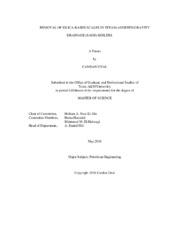| dc.description.abstract | Steam assisted gravity-drainage (SAGD) is a method to produce bitumen or extra-heavy oil by injecting steam into the reservoir. The steam lowers the viscosity and the mixture of oil and water are then able to flow through production well. After separating produced water and oil, the water is recycled to the steam generation system for economic and environmental reasons. The water then goes through treatment processes, and it is used in a once-through steam generator (OTSG) with additional water (makeup water) to produce steam for the SAGD injectors. At high pressure and temperature conditions, hard scales are formed on the inside surface of the boiler tubes. The fuel consumption increases as the scales decrease the thermal efficiency. The scale build-up might lead to plugging and boiler failure.
The objectives of this study are to 1) investigate the compositions of four different silica scales from SAGD boilers, 2) study the effect of different treatment solutions on the solubility of those silica scales, and 3) examine the effect of temperature on the working mechanisms of those solutions to find the most efficient formulation to dissolve the problematic scales.
Four different scale samples from SAGD boilers were analyzed to determine an effective and compatible solution to dissolve them. After removing organic matter by using xylene, the mineralogy of these samples was analyzed by using X-ray diffraction (XRD), X-ray fluorescence (XRF), scanning electron microscopy (SEM), and energy dispersive spectroscopy (EDS) before applying any treatment method.
The dissolution tests were conducted with four different chemical solutions: 1) preflush with 15 wt% HCl followed by main acid treatment with 9:1 wt% HCl-HF solution, 2) preflush with 10 wt% NaGLDA followed by main acid treatment with 10:1 wt% NaGLDA-HF solution, 3) preflush with 9 wt% formic acid followed by main acid treatment with 9:1 wt% formic acid-HF solution, and 4) 5 wt% KOH solution. Tests were run at 77 and 300ºF for three hours.
The ion concentrations in the filtrates were analyzed by using inductively coupled plasma (ICP) after all dissolution tests. Furthermore, solubility values also helped to draw a conclusion about compatibility of solution sets with scale samples by running dissolution tests. The HCl treatment set (preflush with 10 wt% HCl followed by main acid treatment with 9:1 wt% HCl-HF solution) was the most effective solution at 77 and 300ºF in terms of high total dissolved scale forming ions in solution and high solubility values. | en |


